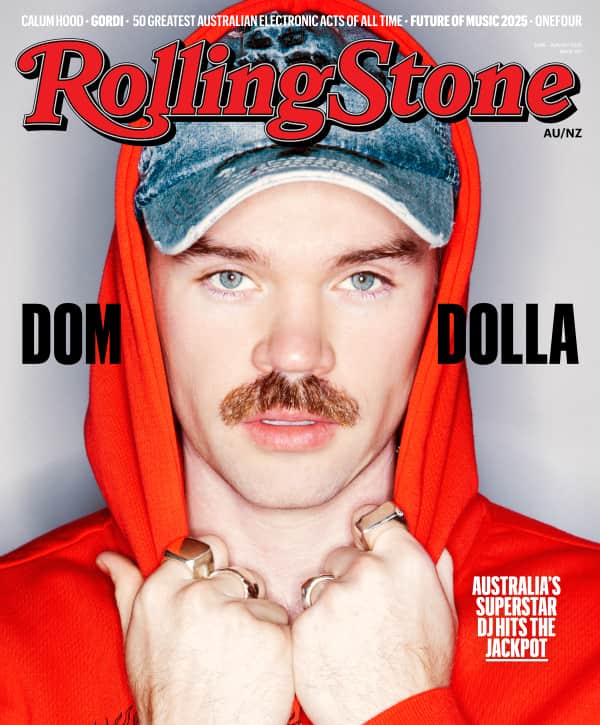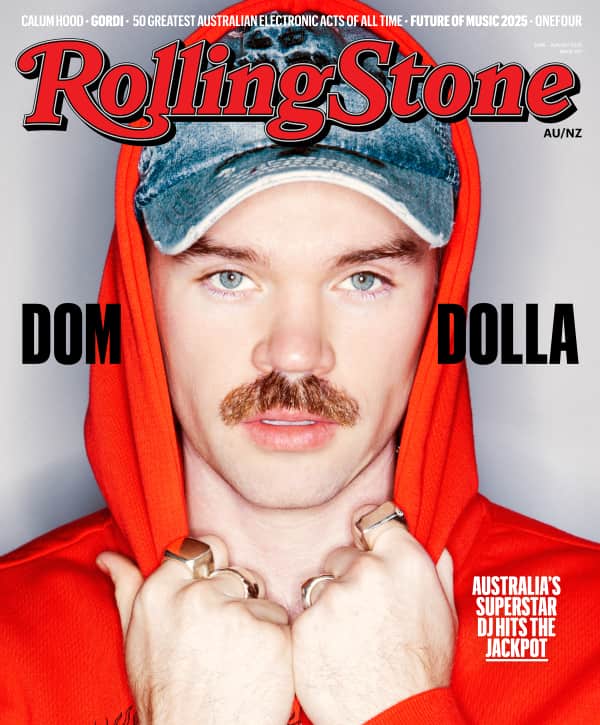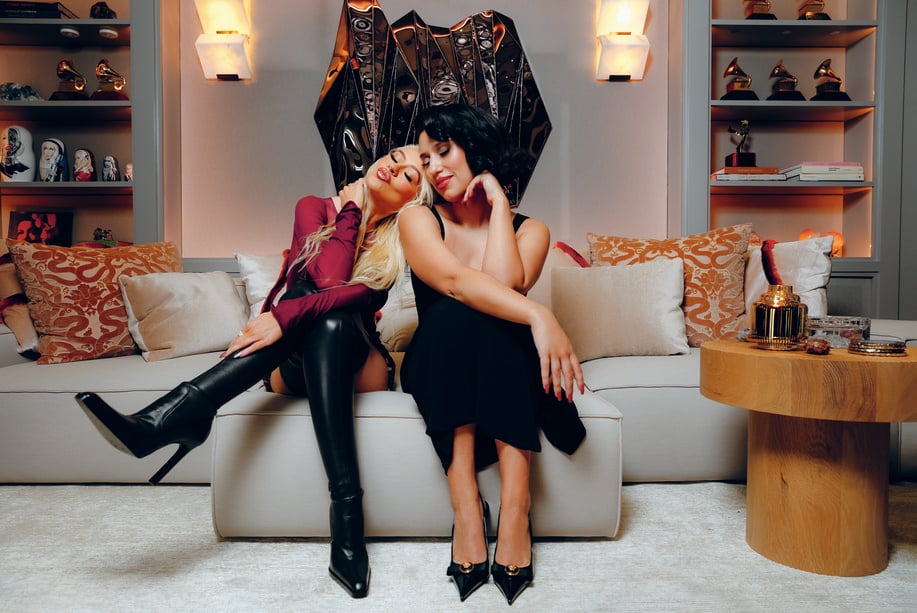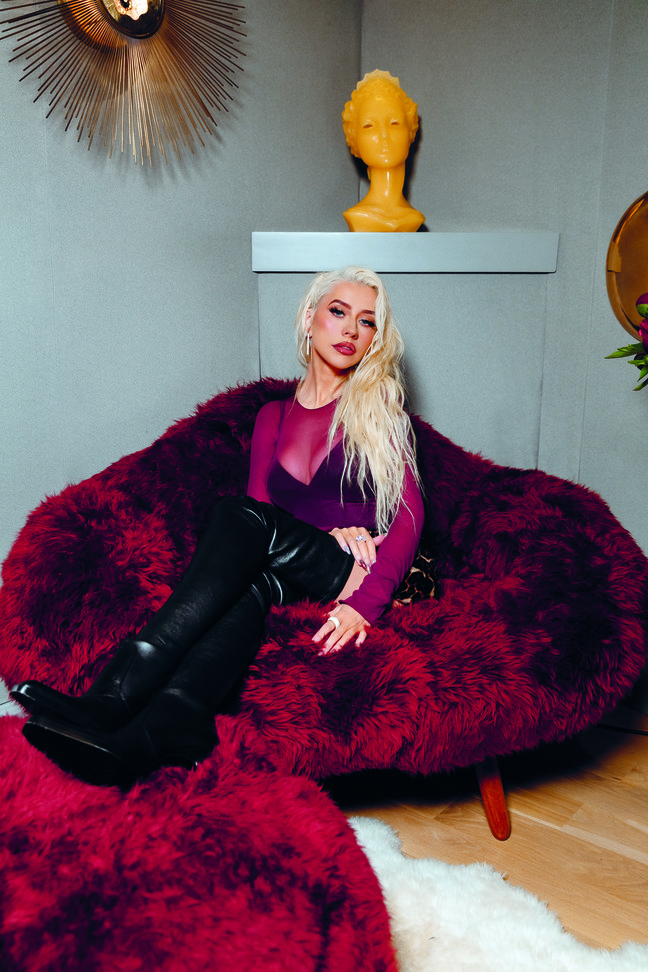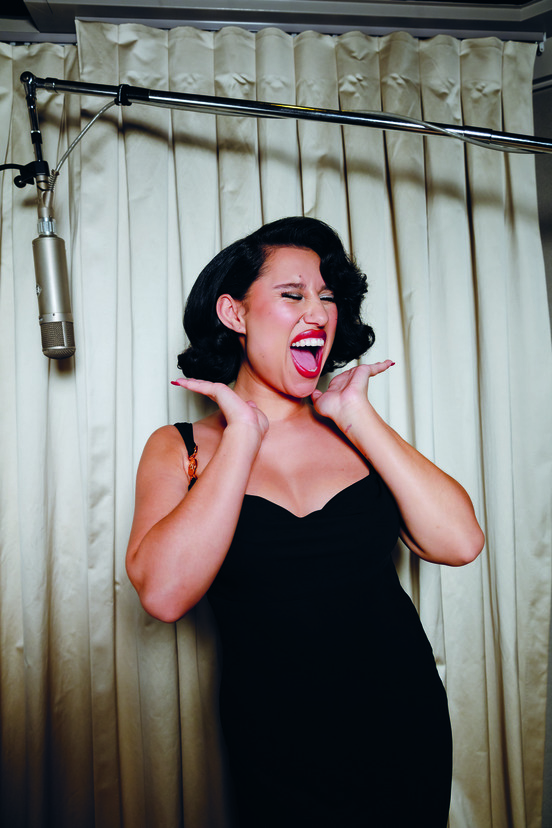Raye, wearing a black, form-fitting Versace dress, can hardly contain her smile as she thinks about that legendary Christina Aguilera riff in Burlesque. You know, the one at the end of her “Show Me How You Burlesque” number, where her voice does cartwheels up and down a scale? Yeah, Raye knows it perfectly. “When I tell you I studied that run, I studied that run,” says Raye. “YouTube, me. The living room. Door shut. Play, rewind. Play, rewind.”
It just so happens that Raye is sitting in Aguilera’s living room, admiring the colourful art on her walls (there’s an iconic Banksy painting on one). They’re about to meet for the first time, and Raye is quickly going over the list of questions she has for the diva.
“She’s ready,” a voice says from the distance. Seconds later, Aguilera struts down a burgundy staircase that matches her blouse. At the bottom of the stairs, Raye is waiting excitedly. “You look beautiful!” Aguilera tells her as she leans in for a hug.
For the next hour, the singers pose for photos in Aguilera’s home studio. The space is small, but it feels a little like an Aguilera museum, adorned with the singer’s collection of Grammy and Latin Grammy trophies for classics like “Beautiful” and “Ain’t No Other Man” — all of which Raye grew up listening to in Tooting, her hometown district in South London. Aguilera also has framed photos of influential vocalists like Etta James, one of Raye’s favourites and a jazz influence that drew Aguilera to Raye’s music. (Raye just released her concert album Live at Montreux Jazz Festival.)
Though they don’t know each other, they trade stories like they’re old friends. “We’ve been itching to talk to each other, but we’ve been trying to save it for the interview!” jokes Raye. During their chat, the pair connect over their love for live instruments, the importance of finding the right team, and tips for recording the best vocals. (At one point, Aguilera pulls out a stack of papers with questions she has for Raye, too.)
Before Raye leaves, why not attempt a duet version of that Burlesque riff? “I wasn’t ready for this today!” Aguilera says with a laugh. The pair immediately slide into velvet harmonies, as if they had prepared for this moment for weeks. They won’t attempt to hit the song’s crazy high notes; they just let their voices float with each other’s. “I could do that 10 more times!” Aguilera says.
Aguilera: Thank you so much for doing this and being here. I’m just so in awe and love with your talent and your voice. I’m such a fan.
Love Music?
Get your daily dose of everything happening in Australian/New Zealand music and globally.
Raye: I can’t believe that. And thanks for having us in your beautiful home. It really is an honour.
Aguilera: I’m curious about your process. How do you get your orchestra from city to city?
Raye: I love musicians. That’s the number one must onstage, even if the stage is looking dusty. I have a core band of five who come with me for everything. Also, it’s important when you’re on the road that you just have people that you love, that you can cry in front of and just feel safe. Ever since we started using brass onstage, I’ve been obsessed.
Aguilera: I was able to do the show at the Hollywood Bowl with the [LA] Philharmonic. I was like a kid in the candy store, where I’m just like, “Oh, my God. Orchestral arrangements of ‘Genie in a Bottle’.” I love where you come in [with] your musicianship and artistry. It’s about music first. When I saw you live, I was like, “What? Oh, she’s going to be around.” I was drawn to it because you’re so versatile in what you can do. Where do you get all these jazz influences, and what is your family’s musical background?
Raye: I feel like we’re all just sponges. What we listen to and feed ourselves is subconsciously what we regurgitate. I’ve been listening to the greats. It’s just Ella [Fitzgerald] and Etta [James] and Dinah Washington and Dionne Warwick — she tweeted me once, and I nearly died.
Aguilera: But if you’re going to go jazzy, you have to be able to back that up vocally. I love your vibrato. All your note choices. I love listening to true vocalists who choose the intricacies that go into each stylistic choice within a live performance. It’s one thing to do it on a record, but you are challenging yourself with every big performance to see how you’re revamping that. Do you have someone you work very closely with? Because these arrangements are no joke.
Raye: I’ve had this tour manager who’s worked with me since I started out doing shows. And he loves music and plays a couple of instruments. Now, we are at a place where we travel around everywhere together and we make the arrangements. We do it all on a laptop whilst we’re on the road.
Aguilera: It’s your tour manager?
Raye: He used to be a session musician. He’s called Pete Clements. And he’s amazing. But he’s now my musical director. There was a time three years ago when it was looking a bit bleak. A lot of people had been working with me for a long time, and I could only pay just about enough. It costs so much to put on a good show and have people sacrificing their time away from their families to be on the road with you. I had a chat with Pete and everyone, and I was like, “Guys, just stick with me.” And so now we’re looking at each other like, “Wow, we’re making arrangements for shows now every frickin’ other day.” And we’ve pushed through.
Aguilera: Having your solid core people is everything. You can be as talented and as amazing as you want to be, but you have to have the right support system.
Raye: How do you know “This is the right person I’m going to let in”? Trust is such a big thing and feeling safe around people. How do you know who to trust?
Aguilera: You’ll never quite know. I’m a big gut girl. This business is crazy. I think your biggest gift as an artist is to listen. There are a lot of things to be learned over time, and time always tells. You have to protect your space and your energy.
Raye: Were there ever moments in your career where you didn’t feel in control?
Aguilera: When you truly care, you’re a control freak. And it’s really hard to relinquish control. When I came into this business, there was a really big pop boom, and it was very specific what a label wanted a pop star to look like, to sound like. I wanted it so bad. That first record that I did is coming up on [its] 25th anniversary. It’s crazy. I reinvent the material now in new ways, but that was a record in the time where I was told, “Oh, you can’t sing that way. You’re oversinging. We’re not doing runs or ad-libs.” I felt like my voice was stifled. You’re going to have situations where you have no creative control or you’re in a position where your hands are tied. It’s just no place for an artist. When my hands feel too bound and I feel like there’s no breathing room, that’s when I start to suffer.
Raye: That’s so nuts. It even makes me uncomfortable in my skin. Just shut up and let me sing. How did you deal with being a female powerhouse when it was just gatekeepers and sexist men?
Aguilera: There was a time when I was just living in New York as a teenager, shopping for a record deal, couch-hopping… I was around a lot of adult-male conversations, and this is before you felt like you had a say in anything. You’re trying to not upset anyone because, trust me, the wrong person who’s being even inappropriate gets wind of it, then it’s your fault. I’ve been through all of that too. I was told how a woman should act or sound, look like, or feel like from a very male perspective. I was constantly surrounded by male studio heads and producers. And now the industry looks a lot different. Even though social media and all the exposure is a lot sometimes, we can see each other more from our perspectives.
Raye: Do you read comments?
Aguilera: Absolutely not. I cannot be consumed with that aspect all the time. I just can’t do it, literally. I have to have my sanity. I want to live my life — I don’t like to feel affected by people’s opinions. I think that’s so harmful.
Raye: I hear that, girl. What are your top-five favourite songs you’ve written and are most proud of?
Aguilera: Linda Perry, at the time she did “Beautiful” and all of that. She did a lot of work with me on those records. She encouraged me to do a song called “I’m OK”. It was on Stripped, about my reflections on my childhood and my strange relationship with my father and some of the chaos and abuse I had growing up. It’s such a tender song, and I’m literally crying on the record. I wanted to be as vulnerable and open as possible. “Oh Mother” is one that I dedicated to my mom on Back to Basics, about us getting through that. But three would be “Fighter”, just because my fans have adopted that term for themselves. Man, they’ve got such incredible stories.
Raye: I need to jump in here because your run in Burlesque… when I heard it for the first time — and I’ve watched that movie like 12 times — I just absolutely loved it. But that run, I don’t even want to do it in front of you because I can’t, but I rehearsed and practiced. It took me so long to try and get my voice to just do it. And even the way you closed it off was so disgusting. That’s a compliment. Do you freestyle things like that? Or do you do 10 runs and choose the one you love the most?
Aguilera: I’m pretty programmed when it comes to that. I love to get to the point and really perfect what it is we’re doing and go into all the micro details of the little note placements. I have a mathematical approach where if you’re trying to also communicate with an engineer, I’ll sing, like, [sings] “One, two, three, four, five, six, seven, eight.”
Raye: I’m freaking out.
Aguilera: You have to have the right studio engineer, too, even getting the texture and the tone that you want in your voice. I have a lot of brass in my voice. It has a lot of edge to it. The more you know about your instrument, the more of a headache it is because you’re just so picky, and not everyone’s going to cut it.
RS: Raye, what’s your favourite Christina song?
Raye: Well, it’s unfair to ask me to choose one, but I will say that the one that really inspired me as a kid was “Candyman”, because you brought the Sixties and the Fifties. You are one of the only people to have brought it to the mainstream in such a fresh way. I remember being obsessed with the three wigs in the video, with three different hair colours. This is a really hard question to ask. Do you have a song of mine that you like?
Aguilera: I have a few. The first time I heard you was with “Escapism”. The way you wrote that song! Of course, you have a voice, but just the way you so cleverly wrote that song and just tied in all the wordplay. It didn’t sound too forced. It was effortlessly clever and just so cool. How did 070 Shake come up?
Raye: That happened because the engineer that I worked on my album with is also the engineer for Shake. She’s just such an artist’s artist. She doesn’t do promo; she hands in her album to the record label and is like, “This is what you’re getting.” When I met her, I was at such a time when I was in the mill putting out music that I hated. She just said something really potent to me: “If you don’t like your music, then what are you doing this for?” She’s such a real one and so talented.
Aguilera: I’m such a fan of hers too. One from your album that I really love is “Oscar Winning Tears”. It’s sick. That’s the kind of song that I feel would be a fun song to sing.
Raye: You’d eat that song up.
Aguilera: Is it fun to just dig your heels in and… [growls]?
Raye: It is. I love to sing it. It’s one of those songs that when you’re singing it every night, you’re like, “Oh.” You get to that note and you’re like, “Please, Lord, have mercy.” It takes a lot out of you, to do them notes. I’ve been trying to work out how I can put it in a different place in my larynx, so it feels grand, but I’m not killing myself doing it.
Aguilera: There’ll be new songs that are more recent, and I get so in my head and fearful of hitting a note, and I’m like, “Oh.” Then, if I compare it to “Lady Marmalade”, where there’s a lot of big notes and they’ll just sit in the back of my throat: “Wait, that note in ‘Lady M’ or ‘Burlesque’ is higher. But this one is lower, and I’m terrified of it.” It’s a mental game sometimes. I do a vocal warm-up routine. What is your routine before a show?
Raye: I’ll FaceTime my vocal coach, and he has me use this giant straw that I put into a bottle of water [and blow into to clear my vocal pipes].
Aguilera: I’ve never done the straw thing. Does it help? Is it good?
Raye: I quite like it. I think it vibrates subtly any kind of mucus.
Aguilera: Back when my voice was super clean and I was a baby, baby vocalist, I had to drink milkshakes to give me more of that.
Raye: I’m obsessed. That is so fire. Do you think your voice is less clean now than it was before?
Aguilera: I much prefer my voice now, because it has experience, which is what I loved about all the singers that I grew up loving and wanting to emulate. It’s the emotional soaring and singing over the notes or the grain and the grit that goes into a rasp that only comes from experience. You can’t force it or buy it. It just feels lived in. Linda Perry got me over being a perfectionist vocalist in a way. The imperfections become the perfections because it’s where the emotion lies.
RS: Is there a piece of advice that you would want to give Raye?
Aguilera: I think she’s already ahead of the game, to be very honest with you. I mean, even the fact that she sings barefoot. I’ve already fucked up my legs and my feet so bad with all this high-heel nonsense. I fucked up the cartilage in my knee. I love that about you, though. I never had the balls to just do it. Those are the best when you just feel the floor underneath.
Raye: I feel like when I’m wearing shoes, I’m thinking about wearing shoes. Is that weird? I have a question. To your memory, what is the toughest vocal performance you’ve had to do?
Aguilera: Probably “A Song for You”, which I did with Herbie Hancock. It was on an album [called Possibilities]. That arrangement was so intricate, so delicate and full of ad-libs. It was a lot to try and perfect that live. I sang “Run to You” for Whitney Houston in front of her. That was nerve-wracking, but she couldn’t have been more sweet and lovely.
RS: What are you manifesting for yourself and for each other in the future?
Aguilera: A duet?
Raye: We should write together.
Aguilera: I would love that.
Raye: Are you joking? I would love that.
Aguilera: Well, there we go! Thanks, Rolling Stone.
PRODUCTION CREDITS
Executive Producer: KIMBERLY ALEAH. Co-Executive Producer: TARA REID. Associate Producer: VANESSA WILKINS. Director of Photography: NATALIA MOSCOSO. Lighting Technician: GABE SANDOVAL. Camera Operator: ERIKA MORTON. Camera Operator/ Sound Mixer: BRIANA LAWRENCE. Editor: FERNANDO PADRÓN. Color Grading: AYUMI ASHLEY. Photo assistance CHRISTIAN LANZA
The December 2024-February 2025 issue of Rolling Stone AU/NZ is on newsstands now.
Whether you’re a fan of music, you’re a supporter of the local music scene, or you enjoy the thrill of print and longform journalism, then Rolling Stone AU/NZ is exactly what you need. Click the link below for more information regarding a magazine subscription.
Visit the Rolling Stone Musicians on Musicians microsite here.



























